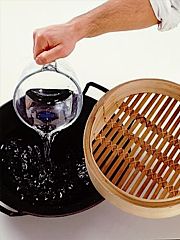If you’ve ever found yourself eating from cardboard and plastic containers using flimsy wooden chopsticks, the phrase ‘healthy Asian cooking’ may sound a little odd at first. However – as with most types of cooking – doing it yourself can make a big, big difference.
This series looks at several basic concepts which will help you put simple, healthy meals on the table whilst keeping the cost down, and the kitchen time to a minimum. It’s very much a win-win-win situation.
 This is definitely one of my favourite cooking methods, and I use it regularly for fish, rice and vegetables. It’s also a great way to reheat a meal without drying it out.
This is definitely one of my favourite cooking methods, and I use it regularly for fish, rice and vegetables. It’s also a great way to reheat a meal without drying it out.
Steaming involves a ridiculously simple setup – a bowl (containing the food) sitting atop a container of boiling water. There are several ways in which to do this :
A wooden steamer basket and a wok : when it comes to steaming foods (apart from rice), this is my usual setup. A bamboo basket (with lid) is placed in a wok; usually sitting about halfway up the sides.
With the basket already in the wok, pour water into the wok so that it covers the bottom half-inch or so of the steamer (try not to flood the floor of the basket itself). This will prevent the wood burning.
Put your plate of food into the basket (or place the food directly in the steamer), put the lid on and switch the gas/electricity on. That’s all there is to it.
NB : Whenever you lift the lid to check on your food, angle the lid away from you. There’ll be a lot of steam in there.
Also, if the water level drops markedly, you may need to add some more. Have a glass ready.
A metal steaming rack and a wok : This method is similar to the one above. The rack will sit about half-way up the wok; put the water in the bottom of the wok, the food on the rack and the lid on the entire thing.
NB : If you don’t have a bamboo steamer or a metal rack for the wok, just put a small bowl in the centre of the wok. Place your plate of food on top of the bowl, and pour some water around the outside. Cover the entire thing with a wok lid, or any large metal lid you’ve got handy.
A large pot and a bowl or plate : Put some water in a large bowl, and cover it with a snug-fitting bowl or plate (containing the food). Place a metal or glass lid over the bowl or plate.
If you’re using a folding metal steamer with the large pot, just put a small bowl in the water, and sit the steamer on top. You can even put another plate of food on top of this. Once again, cover the large pot with a lid.
NB : Many saucepan sets come with several steamers which are designed for stacking. Just remember that if you’re stacking them up, you’ll need to put more water in the bottom pan.
Rice cooker : This probably gets more use than any similar-sized appliance in my kitchen. Although I eat a fair bit of rice, the rice cooker is often used for steaming fish (of course, it can easily accommodate many other foods). Just put some water in the bottom, a plate of food on the metal rack and the lid in place. Beautiful.
Dedicated steamers : If steamed rice doesn’t feature heavily in your diet, a dedicated steamer may be a better choice. The operation is almost identical to that of a rice cooker.
Other options : As with any type of cooking, there’s an incredible range of equipment that can be used. Whatever you have to hand, just remember the general idea – boiling water, food, lid. That’s it.
If you missed the first two articles in this series, head over to :
Enjoy.